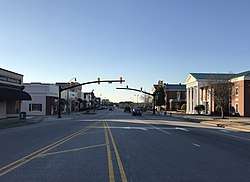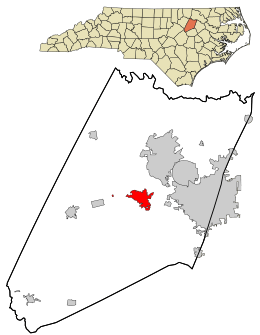Nashville, North Carolina
Nashville is a town in Nash County, North Carolina, United States. The town was founded in 1780 and features a rare collection of Victorian and Queen Anne style homes. It is part of the Rocky Mount, North Carolina Metropolitan Statistical Area. The population of Nashville was 5,352 in 2010. It is the county seat of Nash County.[6] Like Nashville, Tennessee, the town and its county were named for Francis Nash, an officer of the North Carolina militia who died in the American Revolutionary War. The town sits in East Central region of North Carolina, between the Research Triangle and the Coastal Plain. The town is about 35 minutes east of Raleigh.
Nashville, North Carolina | |
|---|---|
 Washington Street downtown | |
| Motto(s): "The Original Town of Nashville" | |
 Location in Nash County and the state of North Carolina. | |
| Coordinates: 35°58′10″N 77°57′41″W | |
| Country | United States |
| State | North Carolina |
| County | Nash |
| Named for | Francis Nash[1] |
| Area | |
| • Total | 4.70 sq mi (12.17 km2) |
| • Land | 4.69 sq mi (12.15 km2) |
| • Water | 0.00 sq mi (0.01 km2) |
| Elevation | 187 ft (57 m) |
| Population (2010) | |
| • Total | 5,352 |
| • Estimate (2019)[3] | 5,554 |
| • Density | 1,183.46/sq mi (456.96/km2) |
| Time zone | UTC-5 (Eastern (EST)) |
| • Summer (DST) | UTC-4 (EDT) |
| ZIP code | 27856 |
| Area code(s) | 252 |
| FIPS code | 37-46000[4] |
| GNIS feature ID | 1021605[5] |
| Website | www.townofnashville.com |
History
The Bissette-Cooley House, Nash County Courthouse, Nashville Historic District, and Rose Hill are listed on the National Register of Historic Places.[7]
Geography
Nashville is located at 35°58′10″N 77°57′41″W (35.969345, -77.961496).[8]
According to the United States Census Bureau, the town has a total area of 3.0 square miles (7.8 km2), all of it land.
Demographics
| Historical population | |||
|---|---|---|---|
| Census | Pop. | %± | |
| 1880 | 212 | — | |
| 1890 | 401 | 89.2% | |
| 1900 | 479 | 19.5% | |
| 1910 | 750 | 56.6% | |
| 1920 | 939 | 25.2% | |
| 1930 | 1,137 | 21.1% | |
| 1940 | 1,171 | 3.0% | |
| 1950 | 1,302 | 11.2% | |
| 1960 | 1,423 | 9.3% | |
| 1970 | 1,670 | 17.4% | |
| 1980 | 3,033 | 81.6% | |
| 1990 | 3,617 | 19.3% | |
| 2000 | 4,309 | 19.1% | |
| 2010 | 5,352 | 24.2% | |
| Est. 2019 | 5,554 | [3] | 3.8% |
| U.S. Decennial Census[9] | |||
As of the census[4] of 2000, there were 4,309 people, 1,629 households, and 1,124 families residing in the town. The population density was 1,425.2 people per square mile (550.9/km2). There were 1,751 housing units at an average density of 579.1 per square mile (223.9/km2). The racial makeup of the town was 54.82% White, 43.10% African American, 0.30% Native American, 0.58% Asian, 0.60% from other races, and 0.60% from two or more races. Hispanic or Latino of any race were 1.25% of the population.
There were 1,629 households, out of which 32.5% had children under the age of 18 living with them, 48.4% were married couples living together, 16.7% had a female householder with no husband present, and 31.0% were non-families. 28.4% of all households were made up of individuals, and 11.8% had someone living alone who was 65 years of age or older. The average household size was 2.43 and the average family size was 2.98.
In the town, the population was spread out, with 23.7% under the age of 18, 7.1% from 18 to 24, 30.4% from 25 to 44, 22.5% from 45 to 64, and 16.3% who were 65 years of age or older. The median age was 38 years. For every 100 females, there were 89.2 males. For every 100 females age 18 and over, there were 84.4 males.
The median income for a household in the town was $36,371, and the median income for a family was $44,180. Males had a median income of $32,282 versus $22,176 for females. The per capita income for the town was $18,603. About 9.5% of families and 10.5% of the population were below the poverty line, including 10.0% of those under age 18 and 15.6% of those age 65 or over.
Notable people
- Archibald Hunter Arrington, born near Nashville, United States Congressman from North Carolina
- J. J. Arrington, NFL running back
- Roy Cooper, born in Nashville, Governor of North Carolina
- Algenon L. Marbley Federal District Court Judge Southern District of Ohio
- Phil Valentine, nationally syndicated talk radio host and movie producer
Blooming Festival
Each Spring, the Nashville Blooming Festival is held and is a major event for the town. The main street is blocked off for carnival rides, vendors, and local business participation. The Nashville Chamber of Commerce produces this event. Local musicians perform outdoors. Nash Arts, which holds arts and cultural events year-round, helps with hosting portions of the Blooming Festival. In 2012, the festival took place May 11–12 (Mother's Day Weekend), with a preceding Carnival May 9, 2012.
References
- http://www.townofnashville.com/history/
- "2019 U.S. Gazetteer Files". United States Census Bureau. Retrieved July 27, 2020.
- "Population and Housing Unit Estimates". United States Census Bureau. May 24, 2020. Retrieved May 27, 2020.
- "U.S. Census website". United States Census Bureau. Retrieved 2008-01-31.
- "US Board on Geographic Names". United States Geological Survey. 2007-10-25. Retrieved 2008-01-31.
- "Find a County". National Association of Counties. Retrieved 2011-06-07.
- "National Register Information System". National Register of Historic Places. National Park Service. July 9, 2010.
- "US Gazetteer files: 2010, 2000, and 1990". United States Census Bureau. 2011-02-12. Retrieved 2011-04-23.
- "Census of Population and Housing". Census.gov. Retrieved June 4, 2015.
External links
- Town website
- The Grey Area newspaper, local newspaper
- Nashville Graphic, local newspaper